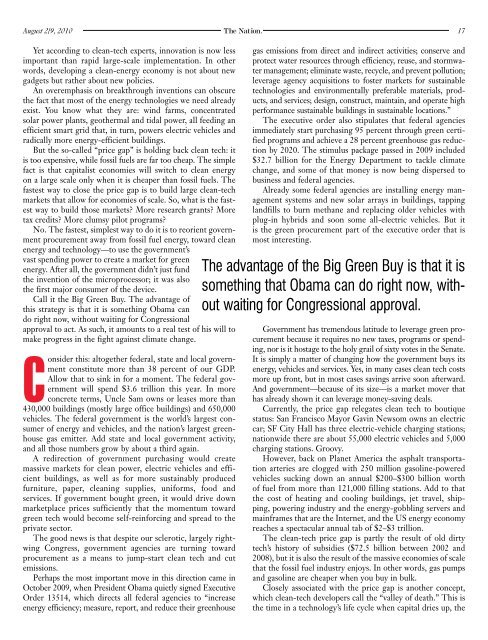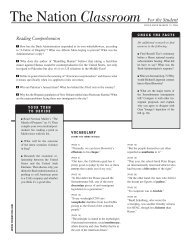Create successful ePaper yourself
Turn your PDF publications into a flip-book with our unique Google optimized e-Paper software.
August 2/9, 2010<br />
Yet according to clean-tech experts, innovation is now less<br />
important than rapid large-scale implementation. In other<br />
words, developing a clean-energy economy is not about new<br />
gadgets but rather about new policies.<br />
An overemphasis on breakthrough inventions can obscure<br />
the fact that most of the energy technologies we need already<br />
exist. You know what they are: wind farms, concentrated<br />
solar power plants, geothermal and tidal power, all feeding an<br />
efficient smart grid that, in turn, powers electric vehicles and<br />
radically more energy-efficient buildings.<br />
But the so-called “price gap” is holding back clean tech: it<br />
is too expensive, while fossil fuels are far too cheap. <strong>The</strong> simple<br />
fact is that capitalist economies will switch to clean energy<br />
on a large scale only when it is cheaper than fossil fuels. <strong>The</strong><br />
fastest way to close the price gap is to build large clean-tech<br />
markets that allow for economies of scale. So, what is the fastest<br />
way to build those markets? More research grants? More<br />
tax credits? More clumsy pilot programs?<br />
No. <strong>The</strong> fastest, simplest way to do it is to reorient government<br />
procurement away from fossil fuel energy, toward clean<br />
energy and technology—to use the government’s<br />
vast spending power to create a market for green<br />
energy. After all, the government didn’t just fund<br />
the invention of the microprocessor; it was also<br />
the first major consumer of the device.<br />
Call it the Big Green Buy. <strong>The</strong> advantage of<br />
this strategy is that it is something Obama can<br />
do right now, without waiting for Congressional<br />
approval to act. As such, it amounts to a real test of his will to<br />
make progress in the fight against climate change.<br />
Consider this: altogether federal, state and local government<br />
constitute more than 38 percent of our GDP.<br />
Allow that to sink in for a moment. <strong>The</strong> federal government<br />
will spend $3.6 trillion this year. In more<br />
concrete terms, Uncle Sam owns or leases more than<br />
430,000 buildings (mostly large office buildings) and 650,000<br />
vehicles. <strong>The</strong> federal government is the world’s largest consumer<br />
of energy and vehicles, and the nation’s largest greenhouse<br />
gas emitter. Add state and local government activity,<br />
and all those numbers grow by about a third again.<br />
A redirection of government purchasing would create<br />
massive markets for clean power, electric vehicles and efficient<br />
buildings, as well as for more sustainably produced<br />
furniture, paper, cleaning supplies, uniforms, food and<br />
serv ices. If government bought green, it would drive down<br />
marketplace prices sufficiently that the momentum toward<br />
green tech would become self-reinforcing and spread to the<br />
private sector.<br />
<strong>The</strong> good news is that despite our sclerotic, largely rightwing<br />
Congress, government agencies are turning toward<br />
procurement as a means to jump-start clean tech and cut<br />
emissions.<br />
Perhaps the most important move in this direction came in<br />
October 2009, when President Obama quietly signed Executive<br />
Order 13514, which directs all federal agencies to “increase<br />
energy efficiency; measure, report, and reduce their greenhouse<br />
<strong>The</strong> <strong>Nation</strong>. 17<br />
gas emissions from direct and indirect activities; conserve and<br />
protect water resources through efficiency, reuse, and stormwater<br />
management; eliminate waste, recycle, and prevent pollution;<br />
leverage agency acquisitions to foster markets for sustainable<br />
technologies and environmentally preferable materials, products,<br />
and services; design, construct, maintain, and operate high<br />
performance sustainable buildings in sustainable locations.”<br />
<strong>The</strong> executive order also stipulates that federal agencies<br />
immediately start purchasing 95 percent through green certified<br />
programs and achieve a 28 percent greenhouse gas reduction<br />
by 2020. <strong>The</strong> stimulus package passed in 2009 included<br />
$32.7 billion for the Energy Department to tackle climate<br />
change, and some of that money is now being dispersed to<br />
business and federal agencies.<br />
Already some federal agencies are installing energy management<br />
systems and new solar arrays in buildings, tapping<br />
landfills to burn methane and replacing older vehicles with<br />
plug-in hybrids and soon some all-electric vehicles. But it<br />
is the green procurement part of the executive order that is<br />
most interesting.<br />
<strong>The</strong> advantage of the Big Green Buy is that it is<br />
something that Obama can do right now, without<br />
waiting for Congressional approval.<br />
Government has tremendous latitude to leverage green procurement<br />
because it requires no new taxes, programs or spending,<br />
nor is it hostage to the holy grail of sixty votes in the Senate.<br />
It is simply a matter of changing how the government buys its<br />
energy, vehicles and services. Yes, in many cases clean tech costs<br />
more up front, but in most cases savings arrive soon afterward.<br />
And government—because of its size—is a market mover that<br />
has already shown it can leverage money-saving deals.<br />
Currently, the price gap relegates clean tech to boutique<br />
status: San Francisco Mayor Gavin Newsom owns an electric<br />
car; SF City Hall has three electric-vehicle charging stations;<br />
nationwide there are about 55,000 electric vehicles and 5,000<br />
charging stations. Groovy.<br />
However, back on Planet America the asphalt transportation<br />
arteries are clogged with 250 million gasoline-powered<br />
vehicles sucking down an annual $200–$300 billion worth<br />
of fuel from more than 121,000 filling stations. Add to that<br />
the cost of heating and cooling buildings, jet travel, shipping,<br />
powering industry and the energy-gobbling servers and<br />
mainframes that are the Internet, and the US energy economy<br />
reaches a spectacular annual tab of $2–$3 trillion.<br />
<strong>The</strong> clean-tech price gap is partly the result of old dirty<br />
tech’s history of subsidies ($72.5 billion between 2002 and<br />
2008), but it is also the result of the massive economies of scale<br />
that the fossil fuel industry enjoys. In other words, gas pumps<br />
and gasoline are cheaper when you buy in bulk.<br />
Closely associated with the price gap is another concept,<br />
which clean-tech developers call the “valley of death.” This is<br />
the time in a technology’s life cycle when capital dries up, the




